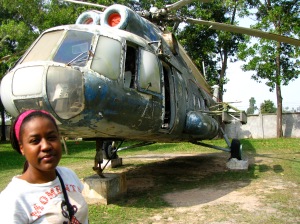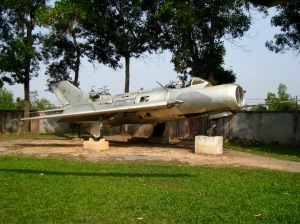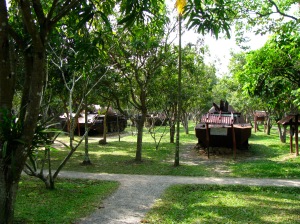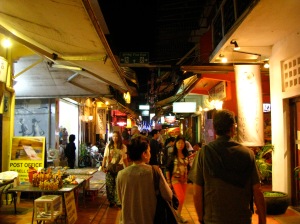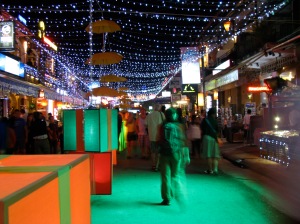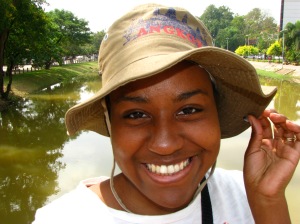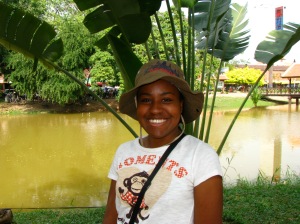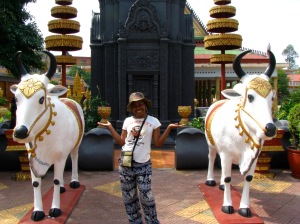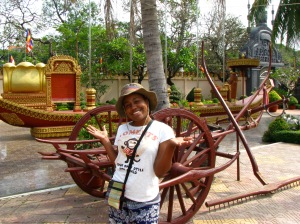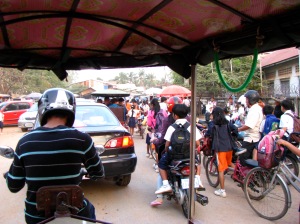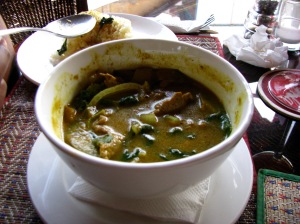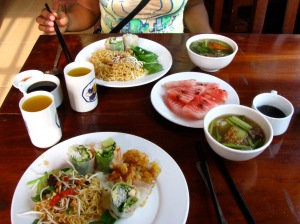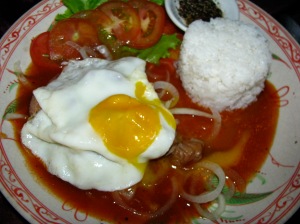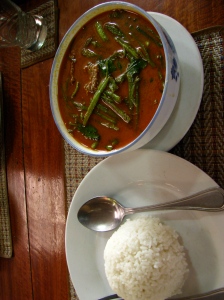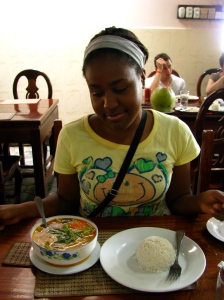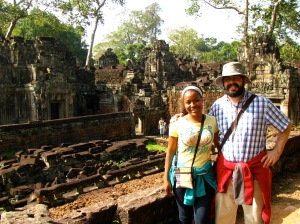On Friday (Day 7), our tuk tuk driver, Mr. G, took us on one more trip. Our Angkor Wat passes were now invalid. We had received three hole punches. We took a shorter trip to the small, outdoor War Museum. I learned a lot more about the civil wars in the ‘70s from our tour guide, who was a kind and friendly man. He showed us the guns, tanks, helicopters, mortar shells, landmines, and other instruments of death and destruction used in Cambodia’s recent, violent past. He explained the differences between various landmines. The plastic kind that don’t wear out from rain and time. The kind that are designed just to blow off a leg. The kind that are designed to spray shrapnel, that blind or kill. The kind that are safe to walk on, designed to target tanks and cars and requiring more weight to trigger. The kind that are tied together with trip wires to blow up around the entire perimeter of a water source, preventing the common people from safely accessing our most precious resource. He explained how the rate of landmine and other old weapon accidents decreased over the years, but was very high even decades after the war. Some children would play with the small shells they found, thinking they looked like toys to be thrown on the ground, only to have those “toys” explode. Many children, he said, did not know about the landmines or where they could be found. “Including me,” he said, lifting up his pant leg and showing us the plastic replacement beneath. He was a soldier in the 90s, he said, when that happened. He has a calm attitude about it, though. He feels more strongly about the landmines that blind or kill people. He went through losing a leg to a landmine, but he can still work. In fact, he said, for some jobs (such as working at the War Museum), you have to be a landmine survivor. In any case, I think landmines are especially heinous. A gun, a tank, or a helicopter is removed from the land when the battle is over, when the soldier wielding it leaves. A landmine is not.
On Friday afternoon we simply took a walk. Mr. G dropped us off in the downtown area and we explored. I really like Siem Reap. It is far different from any other city I’ve been in. (In fact, I’ve seen Siem Reap referred to both as a city and as a town.) It has a very special character. The atmosphere is nice. The downtown area is bustling, but the buildings don’t reach to the skies. Most restaurants have indoor and outdoor seating, and there are plants everywhere. Just outside the downtown area, things get more rural. It’s dusty and dirty, but there are trees. Oh the trees. Beautiful trees. Here you can see houses built on stilts, houses made with whatever materials were available, houses that make no attempt to be airtight. One day, Mr. G asked us if there was snow in our home country. “Yes,” we said. “In Cambodia, if there is snow, all die!” he said. The houses are open. The warm breeze comes in. Snow indeed, and the cold it accompanies, would be a terrible thing. But as it is, the weather is friendly for such living. It’s wonderful. We are not looking forward to returning to winter.
Saturday was our last full day in Cambodia. We rested in our hotel. We took a walk to the river. We sat by the river. In the evening, we went to one more restaurant to eat one more Khmer dish. We really enjoyed eating Khmer food. They have curry with coconut milk and various herbs and leaves that I don’t even know the names of, but that make the soups taste like a tropical island. They have sour spicy soup. They have specially seasoned beef. They have fried noodles. They have amok (steam-cooked curry in banana leaves with a meat or other protein). It’s very good.
The next day we would be crossing the border into Thailand, so part of that day would be spent in Cambodia. However, I want to write a separate entry for Day 9. Here, instead, I’ll sum up our stay in Cambodia, touching on the things we didn’t mention from the previous days and offering some general reactions.
What else did we do?
We saw Phare, the Cambodian Circus, performed by students under the support of the Phare Ponleu Selpak, which you can read about here. We drank smoothies and shakes at Sister Srey Café, which supports Cambodian students (and has really delicious caramel shakes!). We ate lots of Khmer food (so Ashley ordered lamb chops once because she just can’t pass that up, especially when they were only $14, but in general we tried to eat the food of the region, since we’d only be there a short time). We generally had a good time.
And what about Cambodia?
Cambodia is beautiful. It’s so green. Yes, Siem Reap is kind of dirty. There’s trash along some of the streets, especially outside downtown (but also in the downtown area). But it’s beautiful. And the people are so friendly. They have good attitudes. Maybe the tour guide on our Tonle Sap boat ride was a bit bitter about his country’s government, but even he was very friendly and funny.
Since our hotel was not downtown, in fact a twenty-minute walk from downtown, many tuk tuk drivers didn’t know where it was. The hotel card was all in English too, and didn’t have an actual address, but just an area. So that was minimal help in pointing the drivers in the right direction. One friendly driver had a hard time finding the place. He asked another driver if he knew where it was. The other driver mixed up Siem Reap Niche Hotel with La Niche d’Angkor Boutique Hotel, so we went roundabout awhile. He continued to search for and ask about Siem Reap Niche Hotel, showing various people the card and asking for help. As we drove down a dark, deserted road, he said, “I WILL find your hotel, even until morning!”
Of course, not every person you meet will give you a positive encounter. There are, of course, those who are trying to sell you something. And they are very persistent. At nearly every temple and site there are women and children trying to sell scarves (the decorative kind), dresses, magnets, postcards, and other souvenirs. Some men try to sell books and services as tour guides. The women tried to sell Ashley various clothes. “You buy from me, leh-DEEE [lady]. Five dollar. I give you good prai [price].” At the last temple we visited, Banteay Srei, as soon as we entered the path that leads to the site, a young boy said to me, “Give me a dollar!” WHAT? You’re not even selling me something? Well I guess he was, but he said the completely wrong thing. Remembering what our Tonle Sap tour guide said about giving children money, I said to him, “Go to school.” (It was just past noon.) He tried to sell me postcards and said, “You buy and give me a dollar, I go to school in the morning.” Little hustler. At the market buying fruit one day, a little girl saw us and said, “One dollar, sir.” Then she realized she didn’t have anything to sell us and went away.
Before we came, we read that Cambodia was very cheap. And in a way, it is. We stayed at a nice hotel for around $23 a night. (So what if we shared our room with a gecko? It stayed out of our way.) A few restaurants had meals for as low as three dollars (although we didn’t always want those places). Yet somehow, Cambodia is also a bit expensive (compared to its cheap reputation). Ashley overheard someone say that five or ten years ago, the attitudes of the people were more genuine. Now tourists are seen as people with bottomless wallets. A lot of people, from what we’d read online, thought Thailand to be more expensive than Cambodia, but even some Cambodians we met said the opposite.
I talked about some of the negative things of Cambodia here in the wrap-up, but please don’t be dissuaded from visiting. Like I said, it’s a beautiful, beautiful country, with beautiful people. So some of them are trying to sell you something. That’s true of any place. So some of them will try to rip you off. That’s true of any place, too. The food is good, the sites are thought-provoking, and it certainly is possible to visit on a budget, as long as you guard yourself from scams, bargain at the markets, and don’t buy any good or service you hadn’t planned on before arriving. In fact, sometimes we didn’t even have to bargain. We bought a large package of dried mango. We asked the women how much it would cost. “Six dollar,” she said, and Ashley and I looked at each other. We had just walked up to the stall, so we weren’t even sure we wanted to buy mango. While we were considering whether we even wanted it or not, the woman must have thought we were hesitant about the price. “Four dollar,” she said, not five seconds later. “I give you discount, four dollar.” Well, then, okay! (And that kind of thing happened a lot. Just look hesitant about the first offer and they will reduce it for you right away.)
